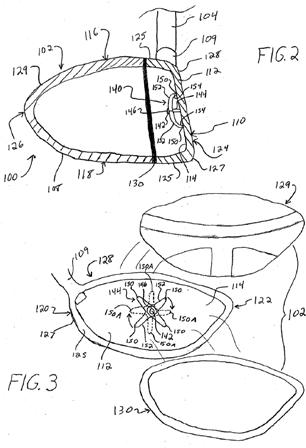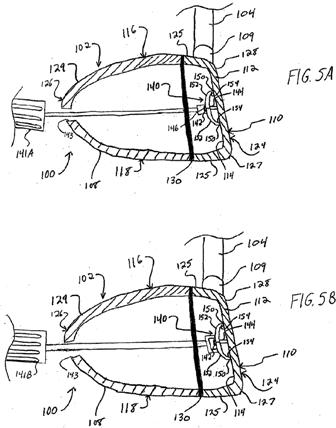Looking for a Little Extra Off the Tee?
Recall the post titled “The Next Step in Club Head Adjustability? Acushnet’s COR Adjustment Patent” from 2-1/2 years ago? If not, check it out and then judge for yourself whether the Acushnet design or the Nike design is more practical.
Nike’s take on the adjustable face stiffness concept was disclosed this week in a patent application that published as US Pub. No. 20100113178 titled “Golf Club Head or Other Ball Striking Device Having Adjustable Stiffened Face Portion.” The application explains:
A ball striking device, such as a golf club head, has a head that includes a face configured for striking a ball and a body connected to the face, the body being adapted for connection of a shaft thereto. The head may include one or more stiffening elements or other structures engaging the face to provide locally increased stiffness to particular areas of the face. The stiffening element can be movable to create regions of increased stiffness in desired locations, leaving other regions of the face to have increased flexibility as compared to the stiffened regions.
.
.
.
[0007] Many off-center golf hits are caused by common errors in swinging the golf club that are committed repeatedly by the golfer, and which may be similarly committed by many other golfers. As a result, patterns can often be detected, where a large percentage of off-center hits occur in certain areas of the club face. For example, one such pattern that has been detected is that many high handicap golfers tend to hit the ball on the low-heel area of the club face and/or on the high-toe area of the club face. Other golfers may tend to miss in other areas of the club face. Because golf clubs are typically designed to contact the ball at or around the center of the face, such off-center hits may result in less energy being transferred to the ball, decreasing the distance of the shot. The energy or velocity transferred to the ball by a golf club also may be related, at least in part, to the flexibility of the club face at the point of contact, and can be expressed using a measurement called “coefficient of restitution” (or “COR”). The maximum COR for golf club heads is currently limited by the USGA at 0.83. Accordingly, a need exists to customize or adjust the local flexibility of a golf club face to provide maximized COR in the areas of the face where off-center hits tend to occur most, without exceeding current COR limitations.
.
.
.
[0010] Aspects of the invention relate to ball striking devices, such as golf clubs, with a head that includes a face configured for striking a ball and a body connected to the face, the body being adapted for connection of a shaft thereto. Various example structures of heads described herein include one or more stiffening elements or other structures engaging the face to provide locally increased stiffness to particular areas of the face. The stiffening element is movable to create targeted regions of increased stiffness (e.g., in the upper heel and/or lower toe quadrants) in desired locations, which leaves other, targeted regions of the face to have increased flexibility as compared to the stiffened regions. By locating the targeted regions of increased face flexibility at locations on a face where a golfer tends to hit the ball, the golf shot may experience increased “kick” off the face on off-center hits (provided the off-center hits impact the face at the locations of increased flexibility and at a sufficient velocity), e.g., due to the increased COR response and a trampoline-like effect at these off-center locations. While increasing the COR response at some targeted off-center locations, the regions of increased stiffness may be used to control the overall club head’s COR response and to assure that the COR of the club head remains within the constraints of the Rules of Golf.[0011] According to one aspect, the stiffening element is moveable and engages a contact point on an inner surface of the face, which can provide locally increased stiffness to the areas of the face proximate the contact point. Movement of the stiffening element changes the contact point on the inner surface, which also changes the area of locally increased stiffness.
[0012] According to another aspect of the invention, the movable stiffening element is rotatably affixed to the face, and the stiffening element is configured for rotational movement. The movable stiffening element may include a pivot member affixed to the inner surface of the face, with an arm extending from the pivot member and being movable by rotating about the pivot member.
Cool stuff, but can it be manufactured into a commercial product?
Dave Dawsey – The Golf Lawyer



